In Florida’s diverse landscapes, nine unique species of woodpeckers contribute to the vibrant ecosystem, each with its own distinctive features and ecological role.
These avian inhabitants play a crucial role in maintaining the balance of the state’s forests, from acting as natural pest controllers to serving as ecosystem engineers.
From the striking Red-headed Woodpecker to the elusive Ivory-billed Woodpecker, this exploration unveils the fascinating world of woodpeckers in Florida.
Join us on a journey through their varied habitats, behaviors, and ecological significance, highlighting the intricate connections between these charismatic birds and the dynamic environments they call home.
Discover the nine woodpecker species that make Florida’s woodlands resonate with life and ecological diversity. Stay focused.
9 Woodpeckers of Florida
Check out the vibrant world of woodpeckers in Florida, each species with its unique characteristics and lifestyles.
From the striking Red-headed Woodpecker to the elusive Ivory-billed Woodpecker, discover details about their scientific names, population status, feeding habits, etc. Get into the diverse avian tapestry of Florida’s woodlands.
1. Red-headed Woodpecker
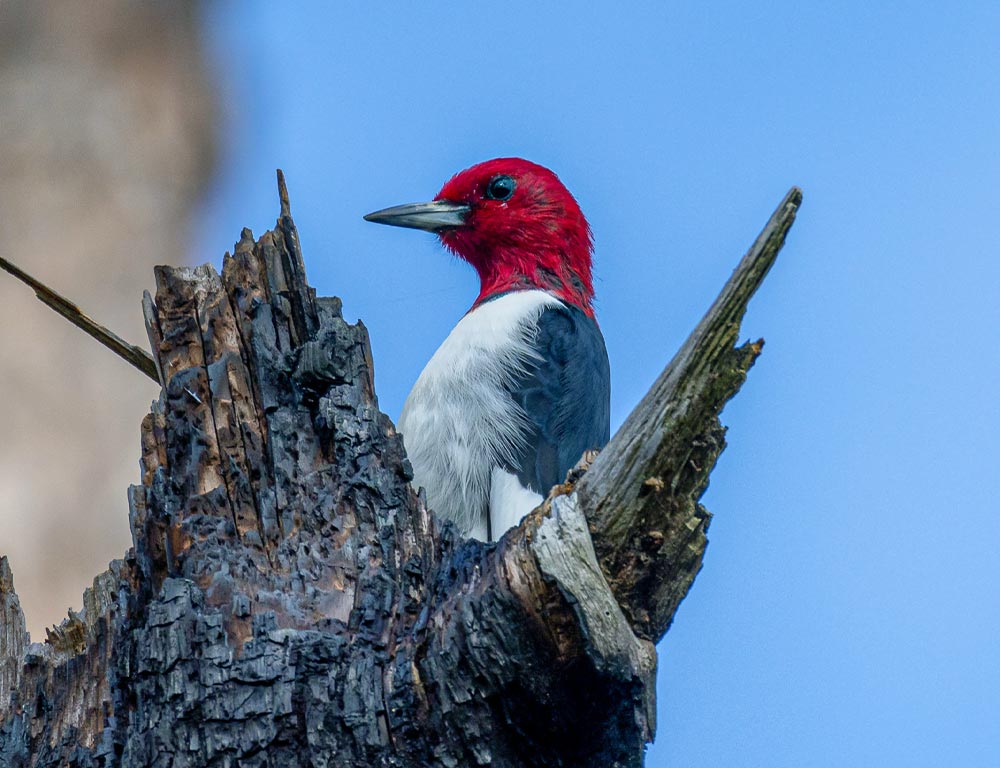
- Scientific Name: Melanerpes erythrocephalus
- Category: Medium-sized woodpecker
- Population: Declining
- Life Span: 9 to 12 years
- Size: 7.5 to 9.8 inches
- Weight: 2.0 to 3.2 ounces
- Food: Insects, fruits, seeds, and occasionally small vertebrates
- Wingspan: 16.5 to 17.7 inches
- Status: Near Threatened
The Red-headed Woodpecker, with its striking plumage, is known for its acrobatic foraging habits. It has a diverse diet, feasting on insects, fruits, seeds, and even small vertebrates.
These woodpeckers are highly territorial and exhibit strong courtship behaviors. They store surplus food by wedging it into bark crevices or even impaling it on thorns.
Unfortunately, their population has declined due to habitat loss, competition with European Starlings, and possibly the West Nile virus. Conservation efforts are underway to protect their habitats and promote nesting opportunities.
2. Pileated Woodpecker
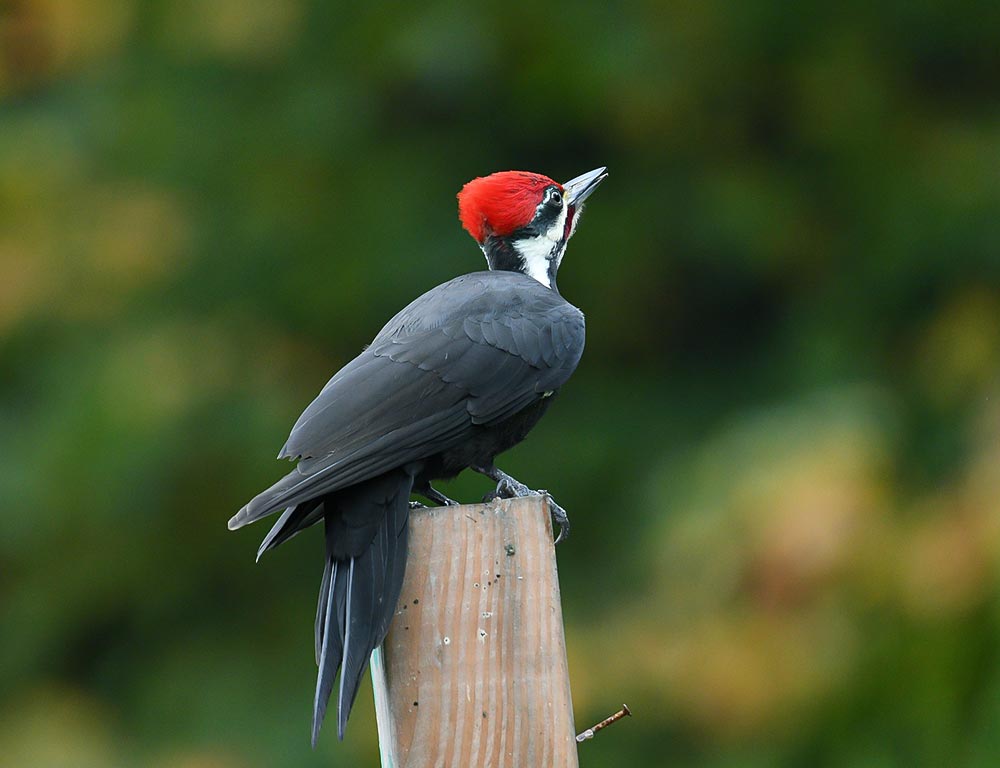
- Scientific Name: Dryocopus pileatus
- Category: Large woodpecker
- Population: Stable
- Life Span: Up to 15 years
- Size: 16 to 19 inches
- Weight: 8.8 to 12.3 ounces
- Food: Insects, especially carpenter ants, and various fruits
- Wingspan: 26 to 30 inches
- Status: Least Concern
The Pileated Woodpecker is the largest woodpecker in North America and has a distinctive appearance with its bold black and white plumage and prominent red crest.
These woodpeckers are adept at excavating large, rectangular holes in trees while searching for carpenter ants. They also feed on fruits and nuts. Pileated Woodpeckers are primarily monogamous and often mate for life.
Their populations are currently stable, benefiting from a broad range of habitats and adaptability to both forested and suburban landscapes.
3. Downy Woodpecker
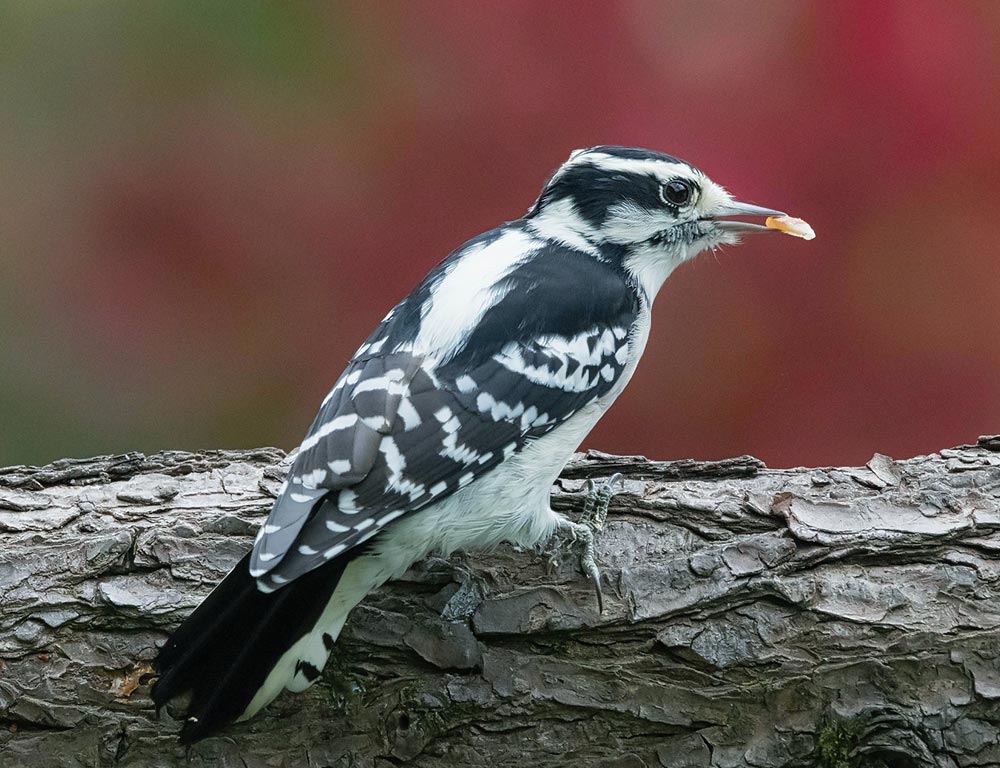
- Scientific Name: Dryobates pubescens
- Category: Small woodpecker
- Population: Stable
- Life Span: Up to 11 years
- Size: 5.5 to 7.1 inches
- Weight: 0.7 to 1.0 ounces
- Food: Insects, seeds, and berries
- Wingspan: 9.8 to 12.2 inches
- Status: Least Concern
The Downy Woodpecker is the smallest woodpecker in North America, recognized by its black and white plumage and small size. Despite their diminutive stature, Downy Woodpeckers are bold and highly adaptable.
They forage for insects, seeds, and berries, often utilizing small branches and shrubs. These woodpeckers are commonly found in various habitats, including woodlands, parks, and suburban areas.
With a stable population, they have successfully adapted to living alongside humans, making them a familiar sight in many Florida landscapes.
4. Red-bellied Woodpecker
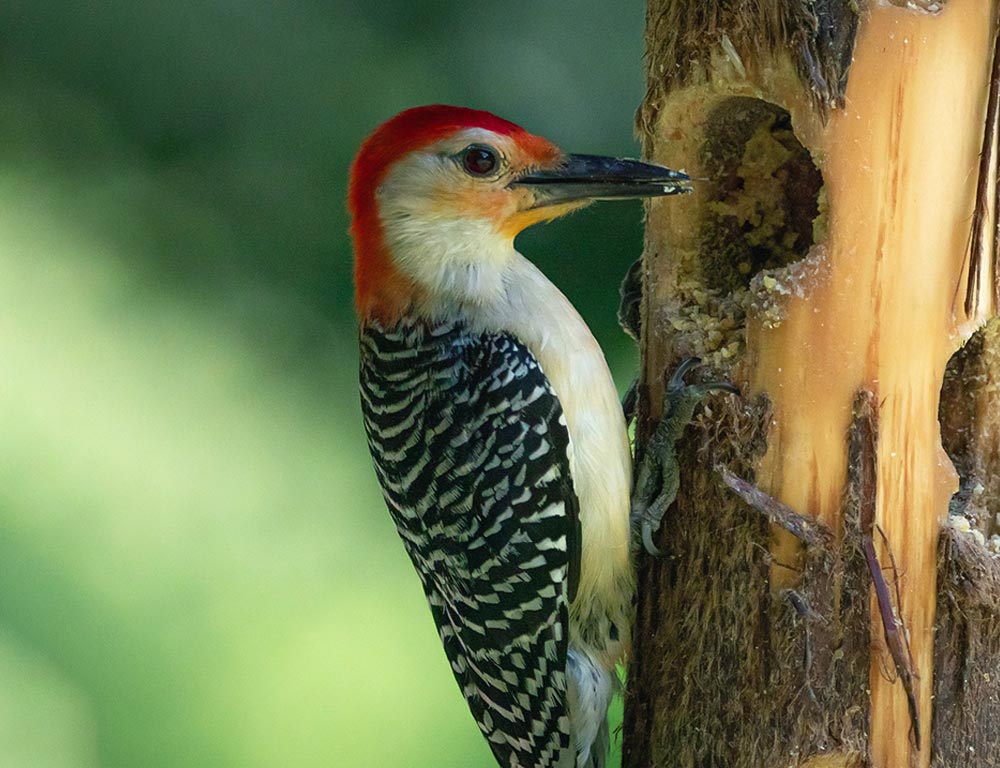
- Scientific Name: Melanerpes carolinus
- Category: Medium-sized woodpecker
- Population: Stable
- Life Span: Up to 9 years
- Size: 9 to 10.5 inches
- Weight: 2 to 3.2 ounces
- Food: Insects, fruits, nuts, and seeds
- Wingspan: 13 to 16 inches
- Status: Least Concern
The Red-bellied Woodpecker is characterized by its zebra-like black and white back and a distinctive red crown on its head.
Contrary to its name, the red patch on its belly is often not visible. These woodpeckers are versatile foragers, feeding on insects, fruits, nuts, and seeds.
They are known for their adaptable nature and can be found in various habitats, including woodlands, suburban areas, and parks.
Red-bellied Woodpeckers are highly vocal and use their calls to communicate with each other. Their populations are currently stable, making them a common and widespread species in Florida.
5. Red-cockaded Woodpecker
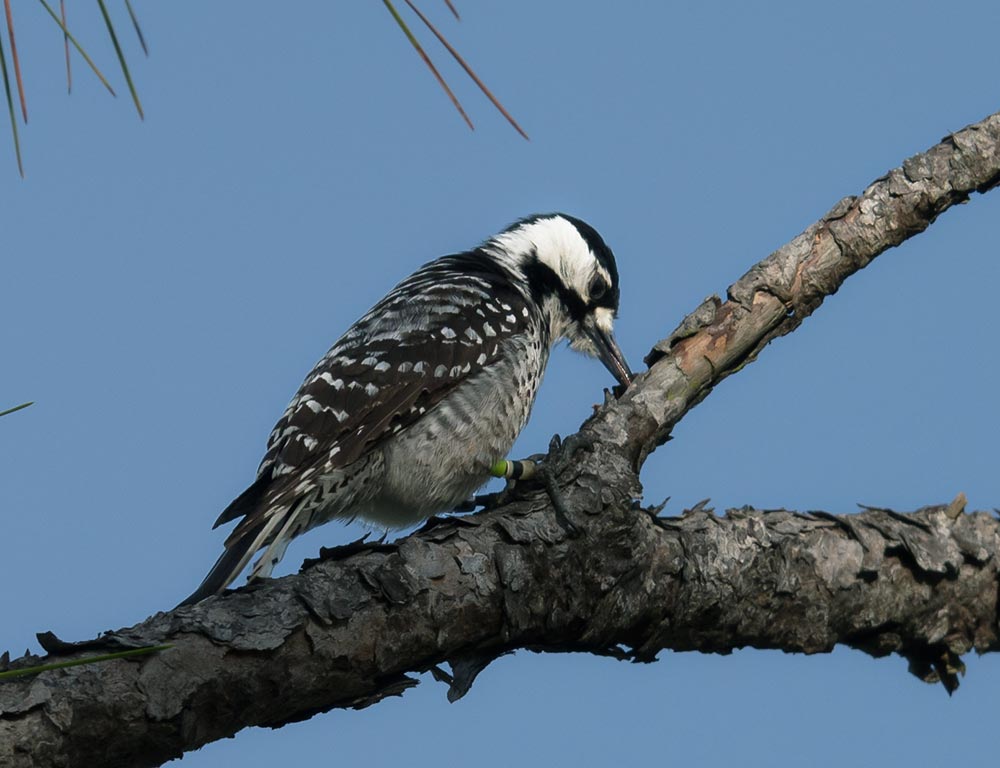
- Scientific Name: Leuconotopicus borealis
- Category: Small to medium-sized woodpecker
- Population: Declining
- Life Span: Up to 10 years
- Size: 8 to 9 inches
- Weight: 1.6 to 2.1 ounces
- Food: Insects, especially wood-boring beetles
- Wingspan: 13 to 16 inches
- Status: Endangered
The Red-cockaded Woodpecker is a unique and highly specialized woodpecker species found in pine forests.
Recognized by its black and white plumage and a small red streak on the side of its head (not always visible), this woodpecker depends on mature pine trees for nesting.
Unfortunately, habitat loss, particularly the decline of longleaf pine ecosystems, has significantly declined their population.
Conservation efforts, including habitat restoration and artificial nest cavity installations, are ongoing to aid in the recovery of this endangered species.
6. Northern Flicker
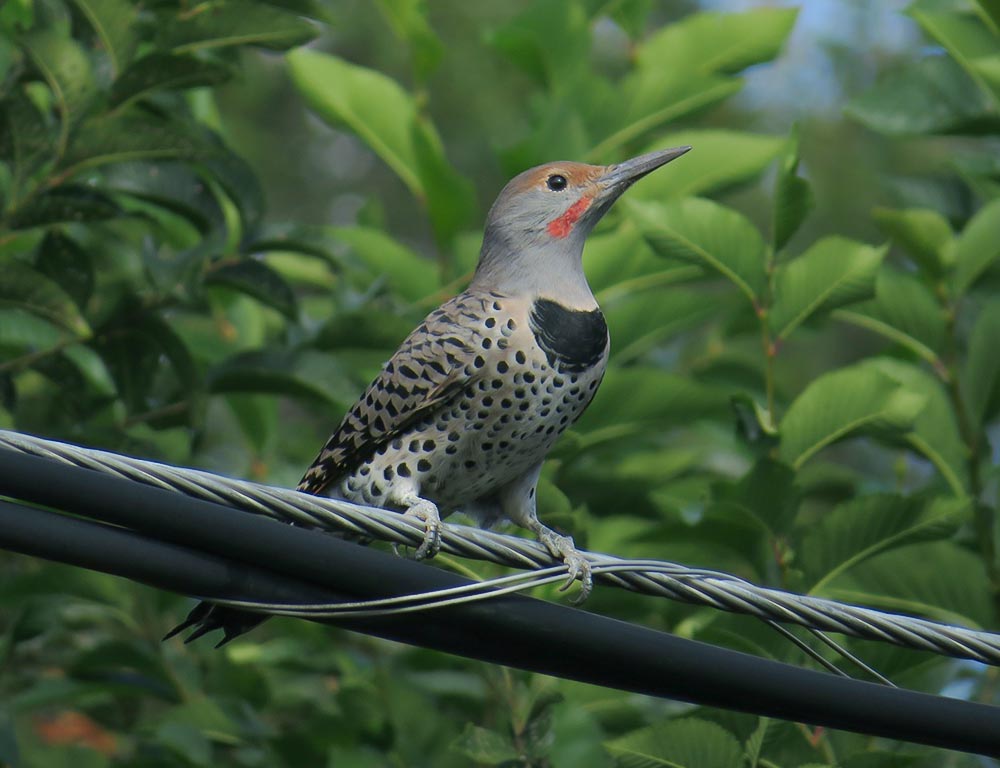
- Scientific Name: Colaptes auratus
- Category: Medium to large-sized woodpecker
- Population: Stable
- Life Span: Up to 9 years
- Size: 11 to 14 inches
- Weight: 3 to 5 ounces
- Food: Insects, seeds, and berries
- Wingspan: 16.5 to 20 inches
- Status: Least Concern
The Northern Flicker is a distinctive woodpecker with spotted plumage and a prominent black crescent on its chest. Unlike many woodpeckers, flickers often forage on the ground for ants and beetles, supplementing their diet with seeds and berries.
They are also known for drumming on objects like dead trees to communicate with other flickers.
These woodpeckers are adaptable to various habitats, including forests, open woodlands, and suburban areas. With a stable population, the Northern Flicker is a common and widespread species across Florida.
7. Yellow-bellied Sapsucker
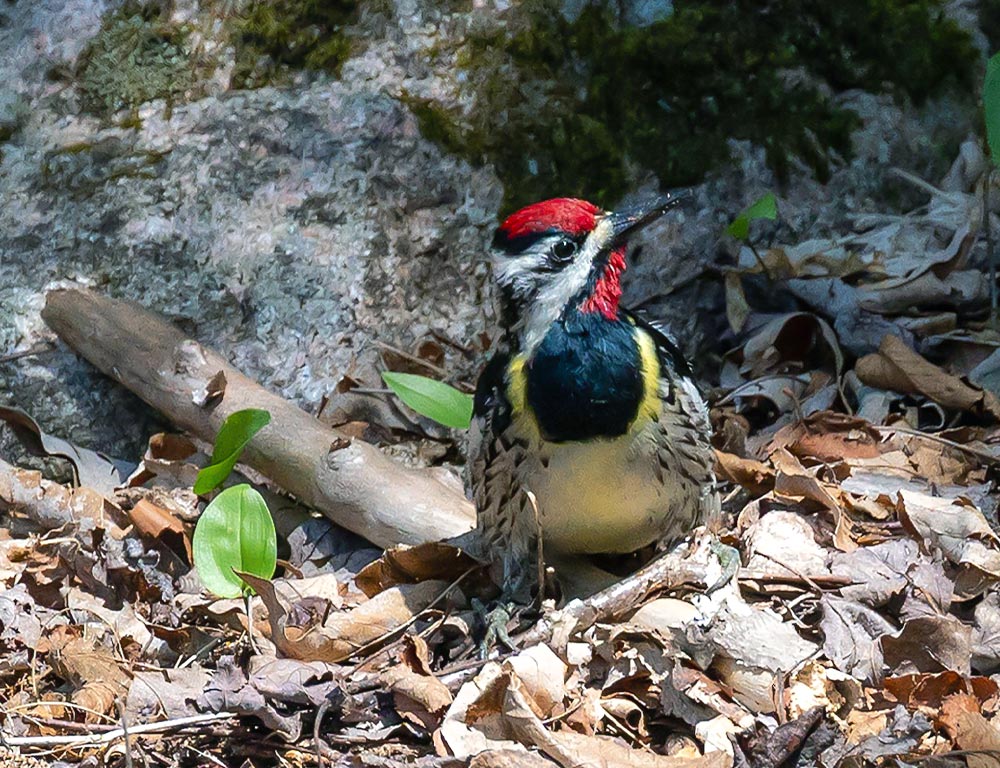
- Scientific Name: Sphyrapicus varius
- Category: Medium-sized woodpecker
- Population: Stable
- Life Span: Up to 8 years
- Size: 7.5 to 8.7 inches
- Weight: 1.5 to 2.1 ounces
- Food: Sap, insects, fruits, and berries
- Wingspan: 13 to 16 inches
- Status: Least Concern
The Yellow-bellied Sapsucker is known for its unique feeding habits, creating small sap wells in trees and feeding on the sap and insects attracted to it. They are recognizable by their black and white plumage, red foreheads, and yellowish wash on their bellies.
Males drum on trees during breeding season to establish territory and attract mates. Yellow-bellied Sapsuckers breed in northern forests and migrate south during the winter.
Despite their distinctive behavior, their populations are considered stable and relatively common in various woodland habitats, including forests in Florida.
8. Ivory-billed Woodpecker
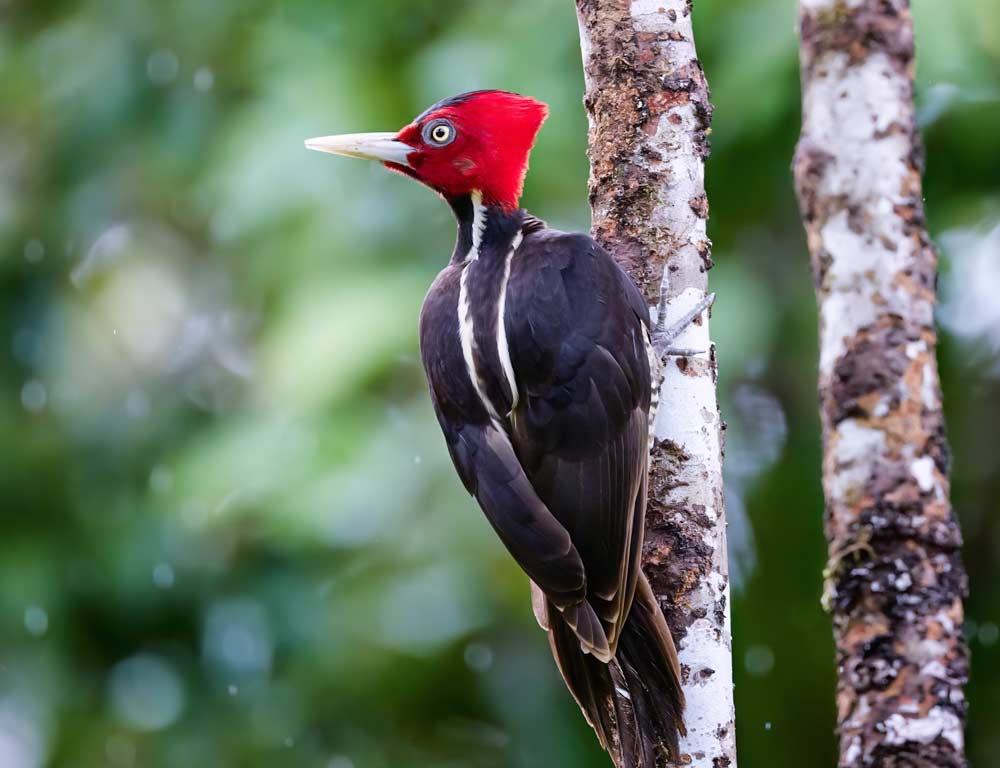
- Scientific Name: Campephilus principalis
- Category: Large woodpecker
- Population: Critically Endangered (Possibly Extinct)
- Life Span: Unknown
- Size: 19 to 21 inches
- Weight: 1.2 to 1.5 pounds
- Food: Insects, especially beetle larvae
- Wingspan: 29 to 30 inches
- Status: Critically Endangered (Possibly Extinct)
The Ivory-billed Woodpecker, once considered the largest woodpecker in the United States, has become one of the rarest birds in the world.
Known for its distinctively large size, black and white plumage, and ivory-colored bill, it primarily fed on beetle larvae in the hardwood forests of the southeastern United States.
Unfortunately, due to extensive habitat loss and potential hunting, the Ivory-billed Woodpecker is believed to be critically endangered and possibly extinct.
Ongoing efforts aim to search for any remaining individuals or evidence of their existence to confirm their status.
9. Golden-fronted Woodpecker
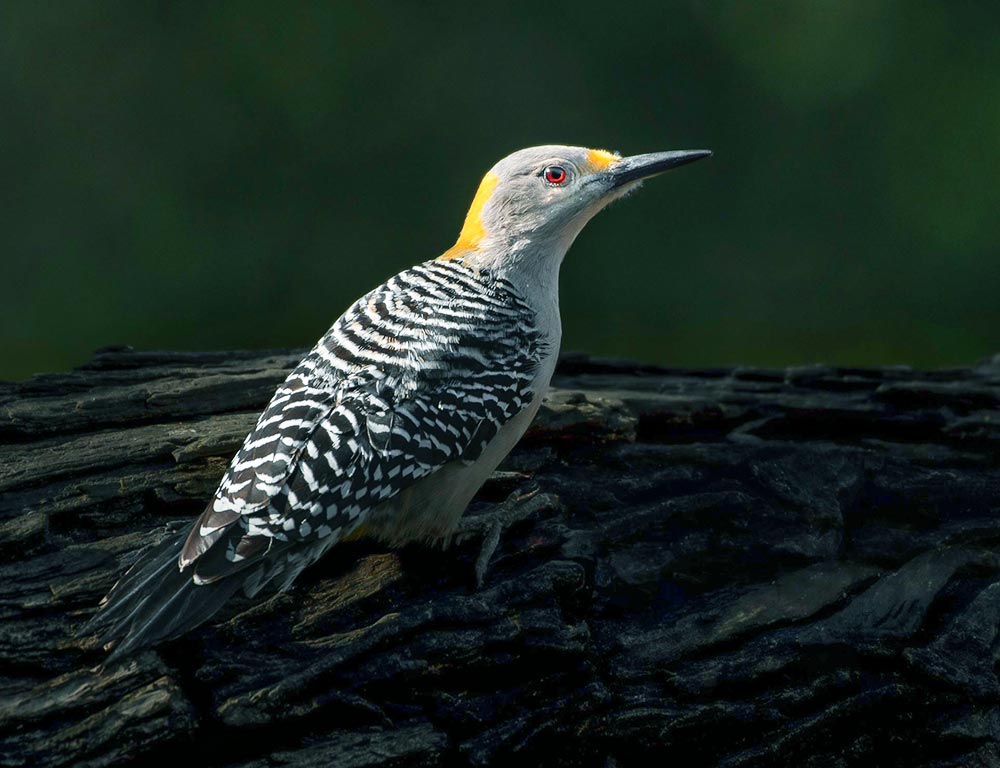
- Scientific Name: Melanerpes aurifrons
- Category: Medium-sized woodpecker
- Population: Stable
- Life Span: Up to 9 years
- Size: 8.3 to 10.2 inches
- Weight: 2 to 3.2 ounces
- Food: Insects, fruits, nuts, and seeds
- Wingspan: 14 to 17 inches
- Status: Least Concern
The Golden-fronted Woodpecker is named for its golden-yellow nape and forehead. With a mix of black, white, and yellow on their plumage, these woodpeckers are highly adaptable, inhabiting various environments, including woodlands, open forests, and urban areas.
They feed on a diverse diet of insects, fruits, nuts, and seeds. Known for their distinctive calls and drumming sounds, Golden-fronted Woodpeckers have a stable population and are commonly found in parts of Florida, as well as throughout the southwestern United States and Mexico.
Ecological Significance of Woodpeckers of Florida
Woodpeckers play a crucial role in Florida’s ecosystems, contributing to biodiversity and influencing the health of forests.
Beyond their striking appearances and distinctive behaviors, these birds have significant ecological importance.
Let’s delve into some of the key points that highlight the ecological significance of woodpeckers in the diverse landscapes of Florida.
Ecosystem Engineers
Woodpeckers are natural engineers, excavating cavities in trees for nesting. These cavities later serve as homes for a variety of wildlife, including other bird species, mammals, and insects, contributing to the overall biodiversity of the region.
Pest Control
Woodpeckers are skilled insect hunters, particularly targeting tree-damaging pests.
By foraging for wood-boring insects, such as beetles and larvae, they help control populations that could otherwise harm trees and disrupt the ecological balance.
Seed Dispersion
As woodpeckers feed on fruits and nuts, they inadvertently become essential seed dispersers.
By transporting seeds to different locations, they aid in the regeneration of forests, promoting plant diversity and assisting in the natural restoration of ecosystems.
Indicators of Forest Health
Woodpeckers are sensitive to changes in their environment. Monitoring their populations and behaviors can serve as indicators of overall forest health.
Declines in woodpecker numbers may signal ecological imbalances or habitat degradation.
Role in Ecotourism
Florida’s diverse woodpecker species contribute to the state’s rich birdwatching opportunities.
Their presence attracts nature enthusiasts and birdwatchers, fostering ecotourism and raising awareness about the importance of preserving natural habitats.
Pollination Assistance
While not primary pollinators, woodpeckers visiting flowers for nectar consumption inadvertently contribute to pollination.
This incidental role aids in the reproduction of flowering plants, further enhancing the biodiversity of Florida’s flora.
Cultural and Educational Value
Woodpeckers hold cultural significance in folklore and indigenous traditions. Understanding their ecological roles fosters appreciation for these birds, contributing to educational programs and conservation initiatives that aim to protect and preserve Florida’s diverse ecosystems.
Wrapping Up
The woodpeckers of Florida emerge not only as captivating avian wonders but as essential contributors to the state’s ecological tapestry.
From their role as ecosystem engineers and pest controllers to their influence on forest health and cultural significance, these birds underscore the interconnectedness of all living organisms.
By understanding and appreciating the ecological significance of woodpeckers, we gain insight into the delicate balance of Florida’s ecosystems.
Preserving their habitats becomes not just a conservation effort for a single species but a commitment to sustaining the biodiversity that defines Florida’s natural beauty. Thank you so much.